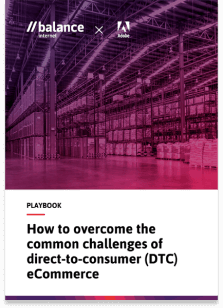Starting a D2C Commerce channel — 3 things to consider
Latest news / 7 June 2021


D2C insights from Adobe’s Head of Digital Transformation, Scott Rigby.
Earlier this year, the team at Balance started working with Scott Rigby, Head of Digital Transformation for APAC at Adobe, to develop a new playbook all about Direct-to-Consumer (D2C) Commerce.
The playbook, which is now available to download below, is titled ‘How to overcome common challenges of D2C Commerce.’
Last year, we noticed a sizeable surge of interest in D2C Commerce channels, which sparked the opportunity for us to work together with Scott and the Adobe team. We wanted to provide B2B organisations exploring D2C with some actionable solutions to the problems they face.
In this blog post, we share three things Scott and the team at Adobe want you to know before you get started in D2C Commerce.
What is D2C Commerce and why does it matter?
As digital commerce continues to accelerate globally, D2C selling is fast becoming an essential play for B2B organisations. Entire industries are adapting and evolving in response to changes in the supply chain.
Globally, eMarketer reports that worldwide eCommerce will approach $5 trillion by the end of 2021. As recently as 2018, worldwide eCommerce sales had not yet topped $3 trillion. eMarketer reports that the $4 trillion line was easily breached in 2020, $5 trillion will be achieved by 2022, and $6 trillion will be reached by 2024. In 2020, 18.0% of all retail sales took place via eCommerce. In 2024, that figure will reach 21.8%.
Closer to home, the global pandemic saw a change in the Australian eCommerce industry on a never-before-seen scale. According to Australia Post, in 2020, more people were shopping online than ever before – up 31% to 5.2 million compared to the average in 2019. Consequently, online goods spending grew by 95% YOY, with online purchases continuing to grow at a rapid rate.
These shifts online have been dramatic and will undoubtedly alter behaviour for pure-D2C Commerce companies, B2B companies, their customers, and the volume of sales D2C will account for moving forward.
eMarketer also reported that D2C Commerce sales from digitally native established brands grew 45.5% last year, generating a whopping $111.54 billion, making up 14% of total retail eCommerce sales. eMarketer further expects relatively steady growth each year through 2023, with D2C Commerce sales set to reach $174.98 billion at that time.
Still not convinced? The US-based direct-to-consumer purchase index predicts that more than 80% of consumers are expected to make at least one purchase through a D2C brand within the next five years.
The case for D2C Commerce in the digital landscape is clear. It is certainly an emerging sales channel and will likely continue to contribute in a significant way to global eCommerce.
The mammoth opportunity for B2B brands
When executed well, the D2C Commerce model can open new revenue streams, grow closer customer relationships, provide improved business efficiencies and offer B2B organisations the chance to enter a growth phase.
What’s more, by creating a D2C Commerce solution, the far-reaching environment and significant advances in eCommerce technology have made it possible for brands to scale and build brand awareness far quicker than if they were to create a physical store.
D2C also offers B2B organisations a platform to test the latest product and service innovation, giving these brands direct access to their consumers’ feedback for analysis and evaluation. A new advantage in many instances, with game-changing access to previously unavailable consumer data.
Three things you should consider before starting a D2C channel:
Is the business clear about D2C’s role in broader operations?
Organisations should place a very high emphasis on working collaboratively with stakeholders when developing a business case for D2C Commerce. It needs to be clear from the onset what the D2C channel will contribute to the overall business so that outcomes are measurable. Developing high-quality, inclusive documentation such as a well-defined business case from the beginning sets the tone for any eCommerce development and is beneficial to all involved.
Best-practice companies we work with are often reasonably clear on the role of D2C in their overall channel strategy before engaging a partner to build the solution. For example, it must be evident in the business case for D2C from the onset what the key objectives are to drive sales, stabilise market share, generate customer insights, generate feedback on new product ranges and services, become the primary or secondary sales channel, or otherwise. Without this clarity, it’s near impossible to measure if the platform has been successful after implementation. It’s also complicated to get various business units to align on the core purpose of the solution and its role for the organisation.
How can you make sure the business is clear about D2C’s role? Scott says collaborative work with business stakeholders and a well-defined business case are crucial to success.
How will you harness the powerful data and analytics of the platform?
D2C companies who want to stay relevant and innovative often look to market leaders or emerging industry trends for inspiration to enhance the customer experience.
According to Scott though, often all the inspiration you could possibly need is right at your fingertips – your customer data and platform analytics.
Understanding what your customers actually want, a vital component of business growth is within your reach with a D2C Commerce platform. From the moment it goes live, organisations have unlimited access to data, which when harnessed effectively can tell you everything you need to know about gaps in the current customer experience.
The most common types of customer needs, such as functionality, convenience, good on-site experience, easy-to-use design, reliability, performance, and efficiency, are constant focus areas for leading D2C organisations we work with. They also never stop striving to improve the customer experience using the data and analytics they have access to.
How can you best harness the platform data and analytics? Scott says that having a data review framework within your organisation is a great place to start. Ensure this is addressed in solution design, and how it can be used across the organisations to drive decision-making where appropriate.
#3 How can your organisation best maximise their technology investment?
To get the most out of a significant investment in technology to implement a D2C channel, organisations should invest appropriately in the right platform and the right solution partner to bring their commerce vision to life.
This is particularly true where complex systems integration is required with existing business systems – working with a flexible and scalable platform to meet your requirements, as is working with a solution partner that can architect a solution to suit your business needs.
Taking a phase-based approach to implementation can also be a highly effective way to demonstrate to your project stakeholders the value of initial investments and keep the project delivery achievable within any business constraints (time, budget, or otherwise) the business may have.
What’s the best way to ensure you are getting the best out of your technology investment? Scott says that organisations should drive maximum value from their technology investment by introducing a robust platform that can consolidate both B2B and D2C offerings from one central location—removing the need for two separate systems can be a game-changer for B2B organisations.
In Summary
We recommend building a well-defined business case for D2C Commerce to nail your approach and clearly define goals before you start development. Further, prioritise using data and analytics to improve your target demographic’s customer experience. Brands can do this by creating a data and analytics framework if they don’t already have one in place. And finally, drive maximum value from your technology investment, starting with assessing how an eCommerce platform could consolidate your organisation’s B2B and D2C operations.



